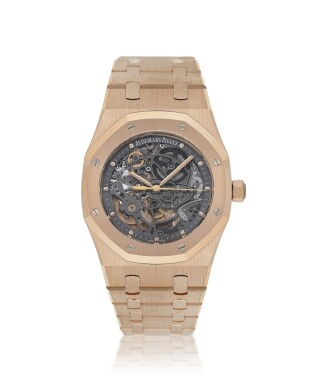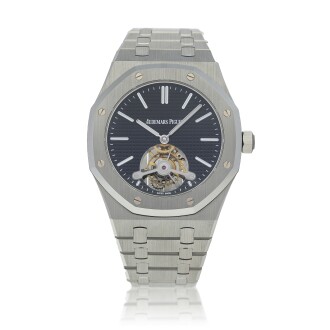T he origin story of the Audemars Piguet Royal Oak is almost as legendary as the design itself. At 4pm on the eve of the Basel Watch Fair in 1970, Georges Golay, managing director of the brand, knew that the company had to come up with a response to the new quartz watches that were wreaking havoc on the Swiss watch industry. Golay called designer Gérald Genta with an urgent request: he needed a “totally new” design for a waterproof steel sports watch to present the following morning to distributors.
The drawings that Genta delivered – inspired by traditional diving helmets – ultimately became the Royal Oak which debuted two years later at Basel in 1972 and became the first stainless steel watch marketed as luxury.
As Audemars Piguet celebrates the 50th anniversary of Genta’s extraordinary design, Sotheby’s has the unprecedented honour of offering a Royal Oak with the most exciting provenance imaginable: the only example to come to market that was owned by the designer himself. This particular lot was acquired by Genta on 15 May 1978 and he wore it for many years. It is also notable as the only stainless steel Reference 5402 with a gold bezel to appear at auction, making it a true one-off.
“One of the great designs of this century. And probably the next.”
While the Royal Oak is now considered a classic, in 1972, it was a revolutionary addition to the horological world. At that time, steel was not considered an appropriate material for the construction of fine watches, especially for a brand primarily known for gold dress watches.
And yet Genta delivered something truly remarkable: a rounded octagonal bezel with eight exposed screws, integrated bracelet, geometric lines and large 39mm diameter that would become iconic.
At first the public were wary of the new design. The idea of a luxury sports watch – especially one with such an industrial aesthetic and made from durable stainless steel – was unheard of. And initially priced at 3,650 Swiss Francs, the Royal Oak was more expensive than a gold Patek Philippe dress watch and over ten times the cost of a Rolex Submariner.
Ironically, although being seen as a less prestigious metal, steel was actually considerably more difficult and time consuming to work with in this context. New techniques and tools were required to create the trademark dual hand-polished and satin-brushed finishes.

The inaugural run of 1,000 pieces took three years for Audemars Piguet to sell but crucially, they were sold to connoisseurs who identified early on that they had a design classic on their hands (or rather, wrists). Today, models from that first production, known as Series A and identified by the “A” engraved on the case-back and the AP initials above 6 o’clock, are the most coveted Royal Oaks among collectors.
In the 50 years since it debuted, there have been many variations on the Royal Oak, which has been produced in different sizes and different materials including gold, platinum, ceramics and titanium as well as different dial designs and colours.
The most successful of these evolutions was the Royal Oak Offshore in 1993 which supersized Genta’s original design to a 42mm diameter and 15mm thickness. Nicknamed “The Beast”, and like the original, it initially polarised buyers before kickstarting a trend for larger timepieces even though,

Today, the Royal Oak, in all its forms, is one of the most desirable watches on the market. Worn by celebrities including Will Smith, Justin Bieber, John Legend and Jay Z (who designed his own version in 2006), it is unsurprising that a watch initially designed for active lifestyles is especially popular with athletes like basketball player, Steph Curry. Serena Williams even has a version customised to wear on the tennis court.
While Genta is undoubtedly one of the most important names in the history of watch design – in 1976, he was also responsible for designing the Patek Philippe Nautilus – it was the Royal Oak, 50 years ago, that cemented him as one of the greats, if not the greatest of all time.












